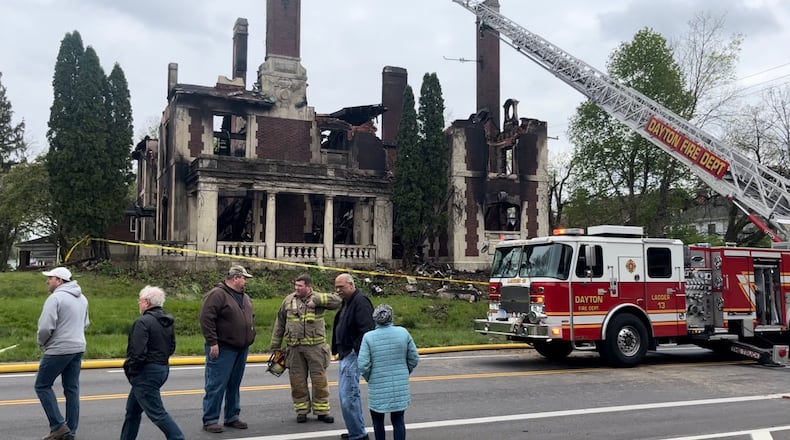But fires dealt serious blows to preserving two more than 100-year-old Dayton sites in recent weeks. Demolition of a Troy tavern building started but was halted by court order. Kettering City Schools is weighing whether to demolish or save key parts of a 94-year-old building if private groups raise enough funds.
Securing funds to renovate sometimes-dilapidated historic structures is a significant challenge. But before even that task comes the debate about which buildings are worth saving.
“The garage where Steve Jobs grew up isn’t a very impressive building, but that’s where they started Apple. So, it’s significant. It has historic significance,” said Brady Kress, president and CEO of Dayton History. “You have those all over the country and all over the world.
Credit: Tom Gilliam
Credit: Tom Gilliam
“The difficulties are just like that. You have some disagreement among folks about whether something is historic or not — or whether it should be historic. Some people have differing opinions,” he added.
Efforts to save aging structures from demolition have received a push locally by Preservation Dayton Inc., which two years ago compiled an endangered properties list.
The original list had 10 sites. They included the Traxler Mansion, which joined the Wright Co. Factory in suffering major fire damage in recent weeks, while two others — the Gem City Ice Cream Building and the Snediker House — were demolished last year by the city of Dayton, citing public safety risks.
Both torn-down structures were on the national historic register, which commonly designates importance to local history and does not protect sites against demolition, officials said.
Preservation Dayton is urging the city to require property owners to better secure and maintain properties. The group wants the city to use the receivership statute to address public nuisance properties and enact civil penalties for LLC-owned public nuisances and derelict properties, organization President Monica Snow has said.
Credit: JIM NOELKER
Credit: JIM NOELKER
The first proposal “can be done immediately if our city commission and city manager get behind this statute,” Snow said. She noted of the second, “the city’s moving forward with this solution, but not quickly enough.”
Dayton Mayor Jeffrey Mims, Jr., and City Manager Shelley Dickstein have not responded to messages seeking comment.
What’s historic?
A common step in an effort to preserve a structure is having it listed as a National Historic Landmark or on the National Register of Historic Places. These designations can help safeguard properties and aid in securing public funding for them, officials said.
Ten sites in Greene, Montgomery and Warren counties are among Ohio’s national landmarks. These include Hawthorn Hill, Orville Wright’s home built in 1914 in Oakwood, and the former homes of Paul Laurence Dunbar and Charles Kettering.
Kress said there’s a “a huge difference” between the two designations, noting that landmarks require “a tremendous amount of more legislative hurdles … to alter or change” a site.
“But being on the register itself does not protect the building from damage, from being altered or from being destroyed,” Kress added.
Credit: JIM NOELKER
Credit: JIM NOELKER
The National Register of Historic Places includes more than 300 sites in Greene, Miami, Montgomery, Preble and Warren counties, 12 of which have been demolished, state records show. Among the 300-plus are the Traxler Mansion and the Wright Co. Factory.
That listing recognizes sites “as worthy of preservation for their local, state, or national significance in American history, architecture, archaeology, engineering or culture,” according to the Ohio History Connection.
Neither a national landmark nor national historic register listing bars property owners from taking action on those sites so long as no federal funding, licensing or permits are involved, according to the national parks service, which approves both designations.
Barb Powers, Ohio History Connection head for inventory and registration, helps nominate properties to the National Register of Historic Places.
“There’s nothing more powerful than place to help you understand where you’ve been, to tell you about your history, provide you with a setting that has character and architectural detail or special features that in many cases are not going to be easily replicated,” said Powers.
“It’s just a very powerful way to convey a community’s history and then retain that, but then project it … to be able to be experienced and appreciated and enjoyed by future generations, too,” she added.
Funding
Getting on the National Register of Historic Places helps make properties eligible for grant funds or other financial incentives, including state and federal historic tax credits, Powers said.
The Ohio Department of Development awarded more than $81 million in tax credits in the last funding round for the state historic preservation tax credit program.
Five of the seven Dayton projects that applied for state historic tax credits won them, and they were awarded about $9.7 million in funding. That included tax credits of more than $3.5 million for the Algonquin Hotel project at 11 S. Ludlow St., and the Centre City Building at 40 S. Main St., plus a $1.39 million tax credit for the former Longfellow School Complex at 245 Salem Ave.
The Dayton Arcade is an example of a project that finished a section of its redevelopment after receiving state historic tax credits.
The city of Dayton has state certification that allows locally designated structures to apply for Ohio tax credits and grants, “even if the building is not listed on the national register,” Tony Kroeger, a city planning and land use manager, said in an email.
Renovating aging sites can be expensive, sometimes requiring investments of millions of dollars depending on the condition and size of a building, officials said.
“That’s the problem with these older buildings,” said Charles Simms, president of Charles Simms Development, which plans to build homes on the former Gem City site.
“They cost way too much to redo and bring up to the current codes — most of them — unless you get some major public partnership money,” he added.
Renovation vs. demolition
The decision to renovate or demolish a structure has several variables, officials said. Restoration costs are “going to vary wildly from structure to structure” depending on original construction materials for facades, roofs and windows, Kress said. “There’s so many factors.”
Credit: HORACE DOZIER SR.
Credit: HORACE DOZIER SR.
Often, he said, “the skills that produced those materials and/or installed those materials, that labor and skill set is hard to find. Try to find a good stone mason these days.”
In Dayton, the city is only an applicant for demolition when the building has been declared a structural nuisance, Kroeger said.
“In that case” per city code, “we need to present compelling evidence that the demolition of the building is the only sensible path forward,” he said.
When a property owner is considering demolition, they have different paths they can take in their application, Kroeger added.
“They can argue that the removal of the property is necessary to facilitate the rehabilitation of a more important structure … In some cases, the redevelopment of the district might also be a sound basis for the application, where the redevelopment proposed will provide mitigation to the loss of the building,” he said.
The most common application concerns the alleviation of an economic burden on the owner, Kroeger said.
“In all cases the applicant must submit a mitigation plan, which is usually either new compatible construction on the sight, or landscaping compatible with the district,” he added.
Kettering, Troy properties
Demolition is being considered with the D.L. Barnes school building in Kettering and the Troy Tavern in Miami County.
The Kettering school board has plans to tear down the former high school and junior high built in 1929, citing a prohibitive cost for taxpayers.
But Kettering officials are talking with private groups interested in coming up with funding to save at least part of the structure, the oldest in the school district.
The latest projected cost to renovate the Far Hills Avenue site is about $16 million, the vast majority of which would require private funds, school officials have said.
Demolition is estimated at $2.5 million. A decision is expected later this year.
The demolition debate with the Troy Tavern in Miami County Common Pleas Court was the focus on a preliminary injunction last month.
A ban on demolishing or removing any part of the structure was agreed to by lawyers for three parties in the legal action. The case involves the city of Troy, Evil Empire LLC and 116 West Main Street.
The city in late March received a court order halting demolition that had started that morning at the rear of the structure by 116 West Main Street, the building owner.
Nancy Bowman and Cornelius Frolik contributed to this report.
National Historic Landmarks
Buildings, sites, districts, structures, and objects that have been determined by the secretary of the interior to be nationally significant in American history and culture. The 10 in Greene, Montgomery and Warren counties are:
• Dayton Veterans Administration Home, Dayton.
• The Paul Laurence Dunbar House, Dayton.
• Fort Ancient, Warren County.
• Hawthorn Hill, Oakwood.
• Huffman Prairie, Greene County.
• The Charles F. Kettering House, Kettering.
• Sunwatch site, Dayton.
• Wright Cycle Co. and Wright and Wright Printing, Dayton.
• Wright Flyer III, Dayton.
• The Col. Charles Young House, Wilberforce.
National Register of Historic Places
Properties recognized by the federal government as worthy of preservation for their local, state or national significance in American history, architecture, archaeology, engineering or culture. More than 300 sites currently stand in Greene, Miami, Montgomery, Preble and Warren counties.
SOURCE: The National Parks Service and the Ohio History Connection.
About the Author






